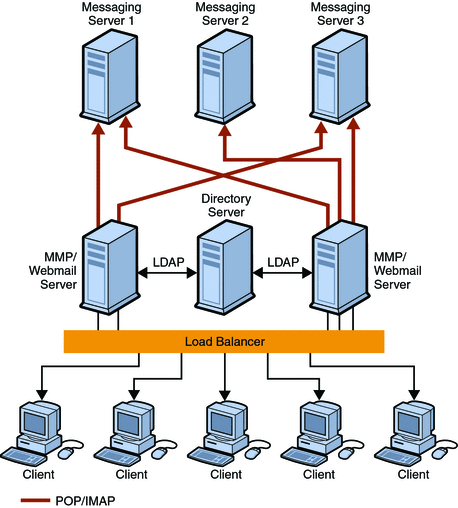Understanding Horizontal and Vertical Scalability in Messaging Server
Scalability is the capacity of your deployment to accommodate growth in the use of messaging services. Scalability determines how well your system can absorb rapid growth in user population. Scalability also determines how well your system can adapt to significant changes in user behavior, for example, when a large percentage of your users want to enable SSL within a month.
This section helps you identify the features you can add to your architecture to accommodate growth on individual servers and across servers. The following topics are covered:
Planning for Horizontal Scalability
Horizontal scalability refers to the ease with which you can add more servers to your architecture. As your user population expands or as user behavior changes, you eventually overload resources of your existing deployment. Careful planning helps you to determine how to appropriately scale your deployment.
If you scale your deployment horizontally, you distribute resources across several servers. There are two methods used for horizontal scalability:
Spreading Your Messaging User Base Across Several Servers
To distribute load across servers is to divide clients’ mail evenly across several back-end Message Stores. You can divide up users alphabetically, by their Class of Service, by their department, or by their physical location and assign them to a specific back-end Message Store host.
Figure 11–2 shows a sample deployment where users are spread across multiple back-end servers and multiplexors enabled to handle incoming client connections.
Figure 11–2 Spreading Your User Base Across Multiple Servers

Spreading users across back-end servers provides simplified user management, as long as you use MMPs or Webmail Servers. Because users connect to one back-end server, where their mail resides, you can standardize setup across all users. This configuration also makes administration of multiple servers easier to manage. And, as the demand for more Messaging Server hosts increases, you can add more hosts seamlessly.
Spreading Your Messaging Resources Across Redundant Components
If email is a critical part of your organization’s day-to-day operations, redundant components, like load balancers, mail exchange (MX) records, and relays are necessary to ensure that the messaging system remains operational.
By using redundant MTAs, you ensure that if one component is disabled, the other is still available. Also, spreading resources across redundant MTAs enables load sharing. This redundancy also provides fault tolerance to the Messaging Server system. Each MTA relay should be able to perform the function of other MTA relays.
Installing redundant network connections to servers and MTAs also provides fault tolerance for network problems. The more critical your messaging deployment is to your organization, the more important it is for you to consider fault tolerance and redundancy.
Additional information on Mail Exchange (MX) Records, and Inbound and Outbound MTAs is described in the following sections.
Mail Exchange (MX) Records
MX records are a type of DNS record that maps one host name to another. Equal priority MX records route messages to redundant inbound MTAs. For example, the sending MTA from the Internet will find that the MX record for siroe.com corresponds to MTAA.siroe.com and MTAB.siroe.com. One of these MTAs is chosen at random, as they have equal priority, and an SMTP connection is opened. If the first MTA chosen does not respond, the mail goes to the other MTA. See the following MX record example:
siroe.com. in MX 10 MTAA.siroe.com siroe.com. in MX 10 MTAB.siroe.com |
Inbound and Outbound MTAs
When Messaging Server hosts are each supporting many users, and there is a heavy load of sending SMTP mail, offload the routing task from the Messaging Server hosts by using separate inbound and outbound MTAs. You can further share the load by designating different MTAs to handle outgoing and incoming messages.
Often, both the inbound and outbound MTAs are combined as a single In/Out SMTP host. To determine if you need one or more MTA hosts, identify the inbound and outbound message traffic characteristics of the overall architecture.
Load Balancers
Load balancing can be used to distribute the load across several servers so that no single server is overwhelmed. A load balancer takes requests from clients and redirects them to an available server by algorithms such as keeping track of each server’s CPU and memory usage. Load balancers are available as software that runs on a common server, as a pure external hardware solution, or as a combined hardware and software package.
Planning for Vertical Scalability
Vertical scalability pertains to adding resources to individual server machines, for example, adding additional CPUs. Each machine is scaled to handle a certain load. In general, you might decide upon vertical scalability in your deployment because you have resource limitations or you are unable to purchase additional hardware as your deployment grows.
To vertically scale your deployment, you need to:
-
Size each messaging component
-
Test the load of a prototype of your system
-
Monitor system performance and adjust the deployment accordingly
- © 2010, Oracle Corporation and/or its affiliates
